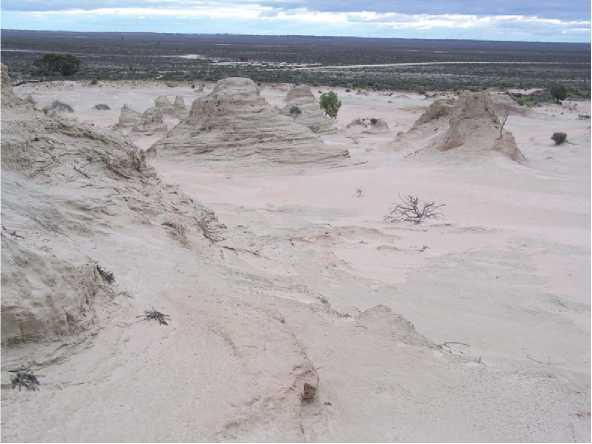Australia was colonized by modern humans, who arrived by watercraft, probably around 45-50 ka. There are very few known examples of Pleistocene

Figure 4 Lake Mungo lunette in the Willandra Lake World Heritage Area. These dunes have yielded the oldest known human remains from Australia and have provided a rich record of human occupation in the semi-arid zone of southeastern Australia. Photograph © Judith Field.
Skeletal remains and these are mainly derived from the southeast of the continent. Different models have been proposed to account for the apparent variation in skeletal morphologies observed among Aboriginal populations. Birdsell’s colonization model involved three separate migrations of people through the Late Pleistocene and his conclusion evolved from the study of the physical appearance of modern Aboriginal populations (see Migrations: Australia). There is little empirical evidence to support his hypothesis, nor the assertions of Alan Thorne who has argued that Australian Aborigines were derived from two different founding populations. Morphologically robust or archaic populations (cf. Kow Swamp, Victoria) were linked to the Homo erectus fossils from the Solo River in Central Java. Morphologically gracile remains (e. g., Lake Mungo) were argued to be derived from the Asian Homo erectus (e. g., Peking Man). Colin Pardoe has further argued that the two morphologies from the Willandra Lakes area are within the documented range for modern humans and represent natural variation explained by sexual dimorphism: robust being male and gracile being female or juvenile.
The ‘unitary origin model’ proposed by Pardoe argues that variation in biological anthropology can be accounted for on the basis of evolutionary principles - adaptation, gene flow, and genetic drift - and does not require multiple founding populations. The colonization of the continent would have been rapid. Differences in physical anthropology have been identified across Australia and necessarily correlate with the environmental zone and population densities or carrying capacity within those zones. Desert peoples are more gracile, following Allen’s and Bergmann’s rule, and have greater sexual dimorphism, in contrast to those peoples from the temperate zone who have a heavier body mass and different body proportions. The apparent near coincident timing of occupation of many different landscapes across the continent supports Pardoe’s proposal for a rapid colonization, with most environments occupied by c. 30 ka. With the onset of the LGM, the more arid regions of the continent were abandoned resulting in changes to the genetic makeup, which is detected in modern day populations that are intermediary between the arid zone and the temperate margins.
Of further interest are the changes in stature and size of humans between the Pleistocene and the Holocene period (post 10 ka) as people became smaller and less robust. These changes have been documented globally; however, in Australia these changes are not correlated to the development of agricultural societies. Different hypotheses have been forwarded to account for these changes and include environmental stress and dietary change.




 World History
World History









